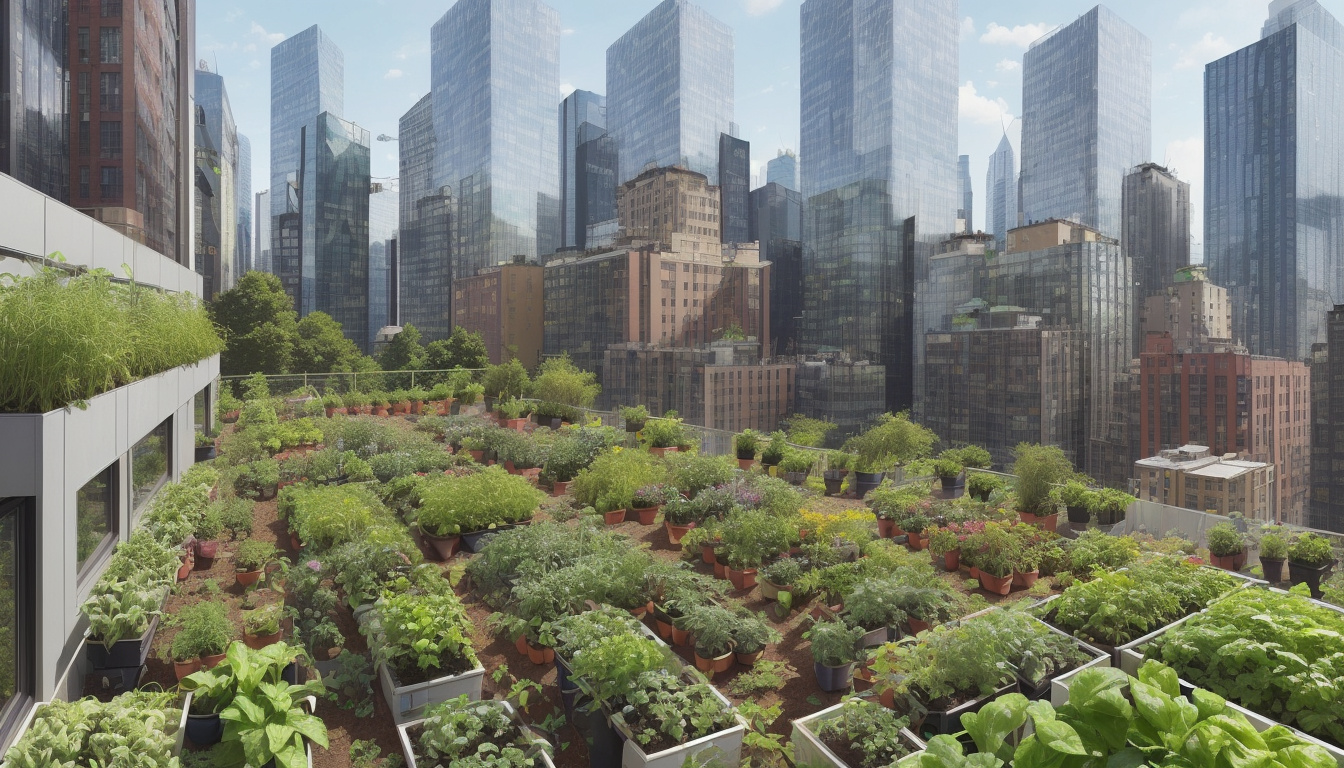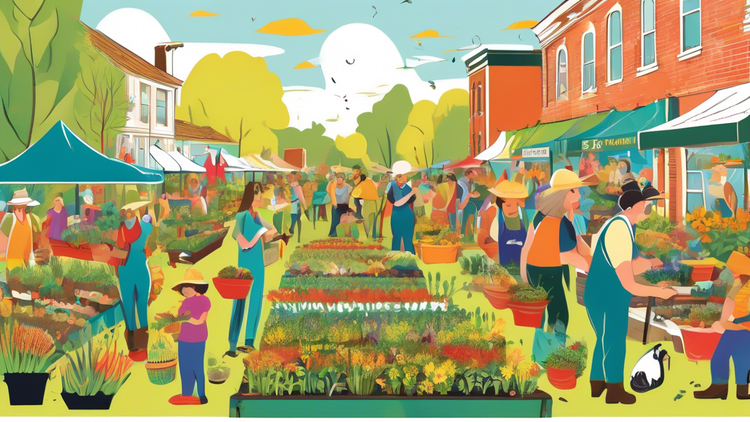Harnessing the Power of Urban Agriculture: Transforming Cityscapes into Green Food Havens

Have you ever thought about the food on your plate and where it comes from? In today's fast-paced urban environment, the distance between farm and fork can be staggering.
But what if I told you that there's a movement aiming to bridge that gap right in the heart of our cities? Enter urban agriculture!
This innovative approach to farming is not just a trend; it has the potential to transform cityscapes into lush, green food havens. In this article, we'll explore what urban agriculture is, the amazing benefits it offers for city dwellers, the different practices involved, the challenges faced, and some inspiring case studies. Plus, we’ll look ahead to see how urban agriculture can shape the future of our cities.
Whether you're a health enthusiast, a farmer, or just a curious consumer, stick with us as we dig into the rich soil of urban agriculture!
Interested in our Digital Magazine APP?

Here's a thought
- Urban agriculture significantly enhances food security and accessibility in cities.
- Implementing urban farming practices contributes to environmental sustainability and biodiversity.
- Community engagement in urban agriculture fosters social interactions and strengthens local connections.
- Despite its benefits, urban agriculture faces challenges such as zoning regulations and land availability.
- Successful case studies demonstrate the potential of urban agriculture to revitalize urban landscapes and economies.
Introduction to Urban Agriculture
Urban agriculture is more than just a trend; it's a growing movement that's transforming how we think about food production in our cities. Imagine stepping outside your apartment and plucking fresh tomatoes right from your rooftop garden! This innovative practice not only brings fresh produce closer to consumers but also promotes sustainability, reduces food miles, and connects communities.
For health enthusiasts, urban agriculture offers a unique opportunity to grow organic fruits and vegetables, ensuring that what you eat is both nutritious and delicious. Farmers, too, are adapting to this new landscape by utilizing small plots of land, vertical gardening techniques, and advanced technology to maximize yield in urban settings. Whether you're interested in enhancing your diet, supporting local farmers, or participating in a community initiative, urban agriculture presents numerous benefits worth exploring.
Benefits of Urban Agriculture for City Dwellers
Urban agriculture is rapidly gaining attention as a transformative practice that brings numerous advantages to city dwellers. For starters, it enhances food security by allowing communities to grow their own fresh produce right in their backyards or on rooftops. This not only reduces reliance on store-bought goods that can be shipped from far away, but also ensures that you’re consuming healthier, pesticide-free fruits and vegetables.
Furthermore, urban agriculture promotes sustainability; by utilizing local resources, you save on transportation costs and decrease your carbon footprint. Additionally, these green spaces contribute to improved air quality and wildlife habitats, making your city more livable. Not to mention, they foster community bonds as neighbors come together to cultivate gardens, share tips, and participate in local farmers' markets. Whether you’re a health enthusiast looking for fresh, nutritious foods, or a farmer wanting to expand your practices into urban settings, embracing urban agriculture presents exciting opportunities for everyone!
'The best time to plant a tree was twenty years ago. The second best time is now.' – Chinese Proverb
Types of Urban Agriculture Practices
Urban agriculture is a transformative approach that blends food production with city living, bringing fresh produce right into the heart of communities. There are numerous types of urban agriculture practices, each suited to different spaces and needs. First and foremost, community gardens are a popular choice, where residents come together to cultivate shared plots, fostering not only a sense of community but also enhancing local biodiversity. Next, rooftop gardens are gaining traction, utilizing otherwise unused spaces atop buildings to grow herbs, vegetables, and even fruits.
Similarly, vertical farming has emerged as a revolutionary practice, with growers using vertically stacked layers to maximize space—perfect for urban environments with limited ground area. Hydroponics and aquaponics represent another exciting avenue in urban agriculture, employing water-based systems to grow plants and, in the latter, integrating fish farming to create an efficient ecosystem.
Finally, urban farmers may also delve into food forests, which mimic natural ecosystems to grow various fruits and nuts, promoting sustainability and reducing urban heat islands. Each of these urban agriculture practices contributes to healthier lifestyles, enhances food security, and strengthens community resilience in today’s fast-paced urban setting.
Interested in our Digital Magazine APP?

Challenges Facing Urban Agriculture
When we think about urban agriculture, we often envision vibrant rooftop gardens, community farms sprouting in vacant lots, and green spaces supporting local food production in the concrete jungle. However, despite its benefits, urban agriculture faces several challenges that can hinder its growth and sustainability. One major issue is land access; as cities expand and property values soar, finding suitable and affordable land for cultivation can be a daunting task for aspiring urban farmers.
Additionally, regulations and zoning laws can restrict the types of agricultural activities that can take place, making it difficult for urban agriculture initiatives to thrive. Water access and quality also pose significant challenges, especially in areas where pollution is a concern. Moreover, without proper funding and resources, many urban agriculture projects struggle to gain traction and sustain long-term growth. Recognizing these challenges is essential for consumers, health enthusiasts, and farmers alike, as it paves the way for finding innovative solutions that could help urban agriculture flourish.
Case Studies of Successful Urban Farming Initiatives
Urban agriculture is gaining traction as a viable solution for food sustainability in cities around the world. Let's explore some inspiring case studies that showcase the successful implementation of urban farming initiatives. For instance, take the example of the 'Brooklyn Grange' in New York, where rooftops have been transformed into lush, productive gardens.
This initiative not only provides fresh produce to local communities but also educates city dwellers about the importance of sustainable farming practices. Another remarkable case is the 'Gotham Greens,' which operates greenhouses right in the urban landscape of various cities. By utilizing advanced hydroponic systems, they grow fresh herbs and greens year-round, significantly reducing transportation emissions and providing fresh food to markets and restaurants in the area.
These urban agriculture projects illustrate how cities can enhance food security, promote environmental responsibility, and create thriving communities. With the rise of urban farming, there’s an exciting opportunity for health enthusiasts, consumers, and farmers to participate in a movement that not only nourishes the body but also nurtures the environment.
Here's something people ask about
What is urban agriculture?
Urban agriculture refers to the practice of cultivating, processing, and distributing food in and around urban areas. This can include community gardens, rooftop farms, vertical gardens, and more.
What are the benefits of urban agriculture for city residents?
Urban agriculture provides numerous benefits, including access to fresh produce, reduction of food deserts, improved air quality, community building, and increased biodiversity in urban areas.
What types of urban agriculture practices are commonly used?
Common types of urban agriculture practices include community gardens, rooftop farms, vertical farming, hydroponics, and aquaponics.
What challenges do urban farmers face?
Urban farmers often encounter challenges such as limited space, soil contamination, zoning regulations, and competition for land use. Additionally, they may struggle with access to water and funding.
How can urban agriculture impact the future of cities?
The future of urban agriculture can greatly impact cities by enhancing food security, reducing carbon footprints, promoting sustainability, and fostering community engagement, ultimately leading to healthier and more resilient urban environments.
We're striving to bring a range of different topics that relate to the Farming Food & Health sector. If you've got a question, please feel free to contact us.
We publish a quarterly magazine available in IOS, Android and Web reader. Stories and articles curated from amazing people all around the world.






